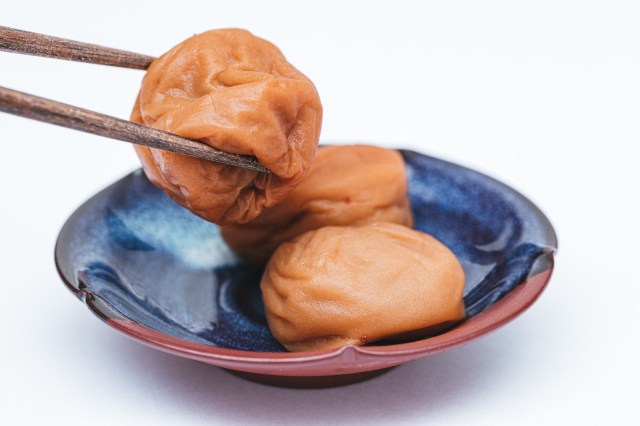
The average Japanese household is eating fewer pickled plums than ever.
Umeboshi are salted pickled Japanese plums that can usually be found atop a bed of white rice, or tucked away in the middle of an onigiri rice ball. Despite their mouth puckering-ly sour taste, they’re a staple that have been eaten throughout Japan for centuries and they’re known to have health benefits too. Umeboshi are said to be beneficial in reducing the risk of diabetes, as well as helping to reduce blood pressure. They are also said to be good for people watching their weight, as they contain a chemical that helps to restrict the bloating of fat cells.
They’re particularly popular amongst the older generation, but research has found that umeboshi have fallen in popularity these days with younger people. Even more troubling for the umeboshi industry, however, is this recent tweet from Baijuen.
Baijuen, an umeboshi wholesale company founded back in 1911, posted to their Twitter account and suggested that it’s not just young people that aren’t eating as much umeboshi these days —
“Everyone, are you aware of the current situation in the umeboshi industry? The annual consumption of umeboshi last year was approximately 663 grams per household. Saying ‘663 grams’ might be a little hard for you to visualise, so in simple terms, umeboshi warehouses are packed with umeboshi with nowhere to go. If this situation continues, many umeboshi businesses will go out of business, including ours.”
663 grams (1.5 pounds) is roughly the same weight as a standard basketball, meaning the average Japanese household ate roughly a basketball’s worth of umeboshi over the year. Granted, umeboshi are significantly smaller than basketballs (and considerably harder to dribble), so it still might be a little tricky to visualise, so here’s an actual, visual representation of 700 grams of umeboshi, slightly more than the average household eats per year.
According to a survey by the Ministry of Internal Affairs and Communications, umeboshi spending peaked around 20 years ago, when the average household was buying 1,053 grams of umeboshi a year. In 2009, that plummeted to 658 grams.
While the cause for umeboshi’s steady decrease in popularity isn’t clear, Baijuen are considering a number of potential reasons. Aside from the fact that umeboshi don’t seem to appeal to the younger generation, many older people have been put off buying umeboshi due to the recent price increase, which came as a result of a poor harvest back in 2020. People are also eating less white rice than before, which is the traditional accompaniment to umeboshi.
Japanese netizens shared their thoughts as to why people aren’t buying umeboshi these days, too.
“I love umeboshi, but they’re too expensive for me so I don’t buy them.”
“I’ve stopped eating umeboshi since I started living alone.”
“All you see in supermarkets these days is umeboshi drenched in honey… I’m not a fan.”
“They should bring back the old fashioned salty umeboshi. These days they’re all too sweet.”
“The umeboshi my late grandma made are the best. I can’t eat any other kind of umeboshi.”
“I’ll happily eat umeboshi if it’s in a bento, but I never purposely go out of my way to buy any when I’m food shopping.”
It’s not all doom and gloom though, as Baijuen’s tweet went viral, with currently over 10 million views and almost 30 thousand retweets. A representative from Baijuen said in an interview with J-Cast News that after the tweet went viral they received a month’s worth of orders in just a day, so there’s hope for Baijuen and the umeboshi industry yet.
Source: J-Cast News via Jin
Featured image: Pakutaso
● Want to hear about SoraNews24’s latest articles as soon as they’re published? Follow us on Facebook and Twitter!